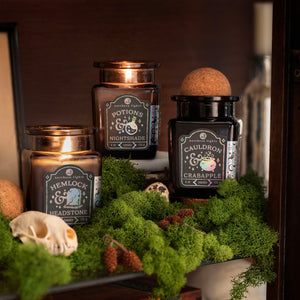Frequently Asked Questions
Why do I need to trim the wicks?
A short wick produces a smaller, more controlled flame that won't emit as much smoke or a blackening of the glass due to an oversized flame.
What's the deal with the Mushroom?
When burning candles, the wick can/will develop a build up of carbon deposits or a black mushroom. This mushroom is caused by a combination of things. The most important is the high volume of fragrance oils. The wick serves as a straw when burning, pulling the fragrance oil through the wax and releasing the fragrance as it burns. When a mushroom is formed, extinguish the flame, let cool, trim wick to ¼" and relight. Without this simple attention, the mushroom could smoke and cause an over-sized flame resulting in a blackening or breaking of the glass.
Which candle will produce the most fragrance?
More fragrance will be emitted from 5 and 3-wick containers. They produce the largest pool of melted wax, therefore creating a larger "simmer pool" that emits the fragrance.
How long should I burn my candle?
We recommend burning container candles long enough to create a pool of wax covering the entire top of the container and pillar candles until a wax pool almost spills over the side.
Will putting candles in the refrigerator make them burn longer?
Refrigerating candles before use will help them burn more slowly and evenly. Candles should be wrapped in foil or plastic before refrigeration to prevent the wicks from absorbing moisture.
Does Northern Lights Candles use lead wicks?
Northern Lights Candles would like to assure you that we do not use lead wicks in any of our products. Let it be known that lead-based wicks have been banned for thirty years now. Most domestic candle manufacturers took lead out of their wicks in the 1970s, though the Consumer Product Safety Commission in 1974 didn't find it a health hazard.
What makes a candle smoke?
A candle can smoke when it burns for several reasons:
1) First, and most common, the wick is too long. Try trimming the wick a little at a time (Wicks should be kept at 1/4" and the candle should be kept out of drafts) with a wick trimmer, old fingernail trimmers or small scissors. Light the candle between each trimming until the candle no longer smokes.
2) Second, the candle may have a property that prevents an even flow of wax into the wick. This can be caused by problems with the scented oils added to the candle during manufacturing or an abundance of non-emulsifiable dye (coloring that can not blend with the wax efficiently). If this is the problem, it may be impossible for the candle to ever burn properly. You may attempt to salvage the candle by pouring off some of the wax into a piece of aluminum foil (discard the foil properly, and responsibly). Remember; never pour wax into any of your drains. The problem may have been isolated to a particular portion of the candle.
3) Third, any form of draft can cause a wick to smoke too.
What makes a candle produce soot?
Candles also need the right amount of wax, air and wick to burn cleanly, so as not create any significant soot. Candle soot is caused by factors such as the length of the wick and the flame's lack of access to oxygen, which causes an overproduction of carbon particles. Soot is the by-product of incomplete combustion. Jar candles are especially prone to the problem.
Candles inside glass jars often produce more soot than freestanding candles because, submerged in the jar, the wick has limited access to oxygen. The key is to trim the wick just enough to eliminate the smoking, yet have it long enough to maintain an adequate size flame to ensure that the candle will burn clean out of the jar. Also, watch when you light the candle. Sometimes soot is formed not by the burning, but by the match or lighter used to light the wick, especially when the candle is deep inside the jar. Try long fireplace matches or long handle lighters.
How can you get rid of soot?
The following soot removal techniques work in many cases, but not in every case. Always follow the instructions and take heed of any warnings printed on cleaning solution packaging.
* Very hot soapy water
* mild detergent and scourer
* Natural orange cleaners




